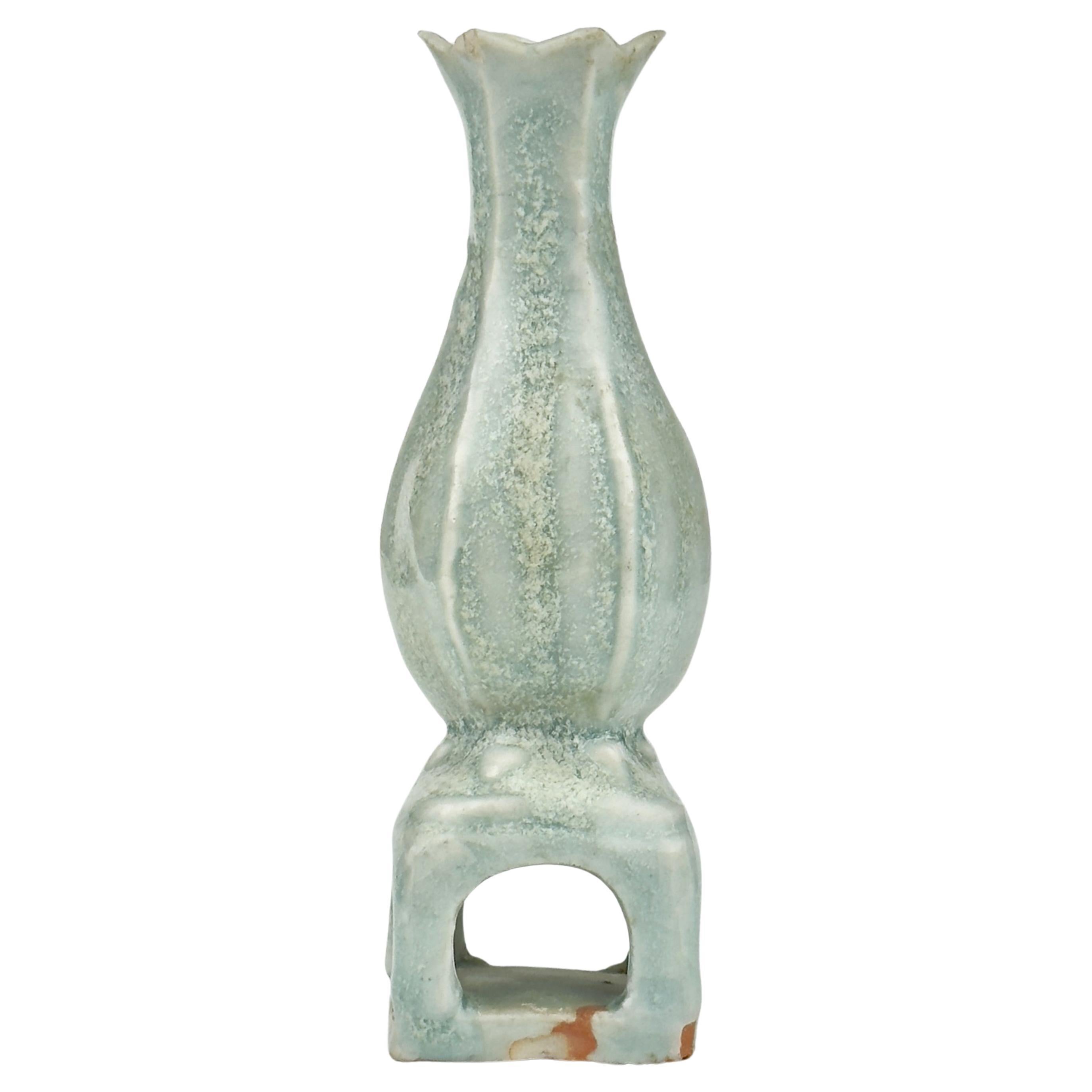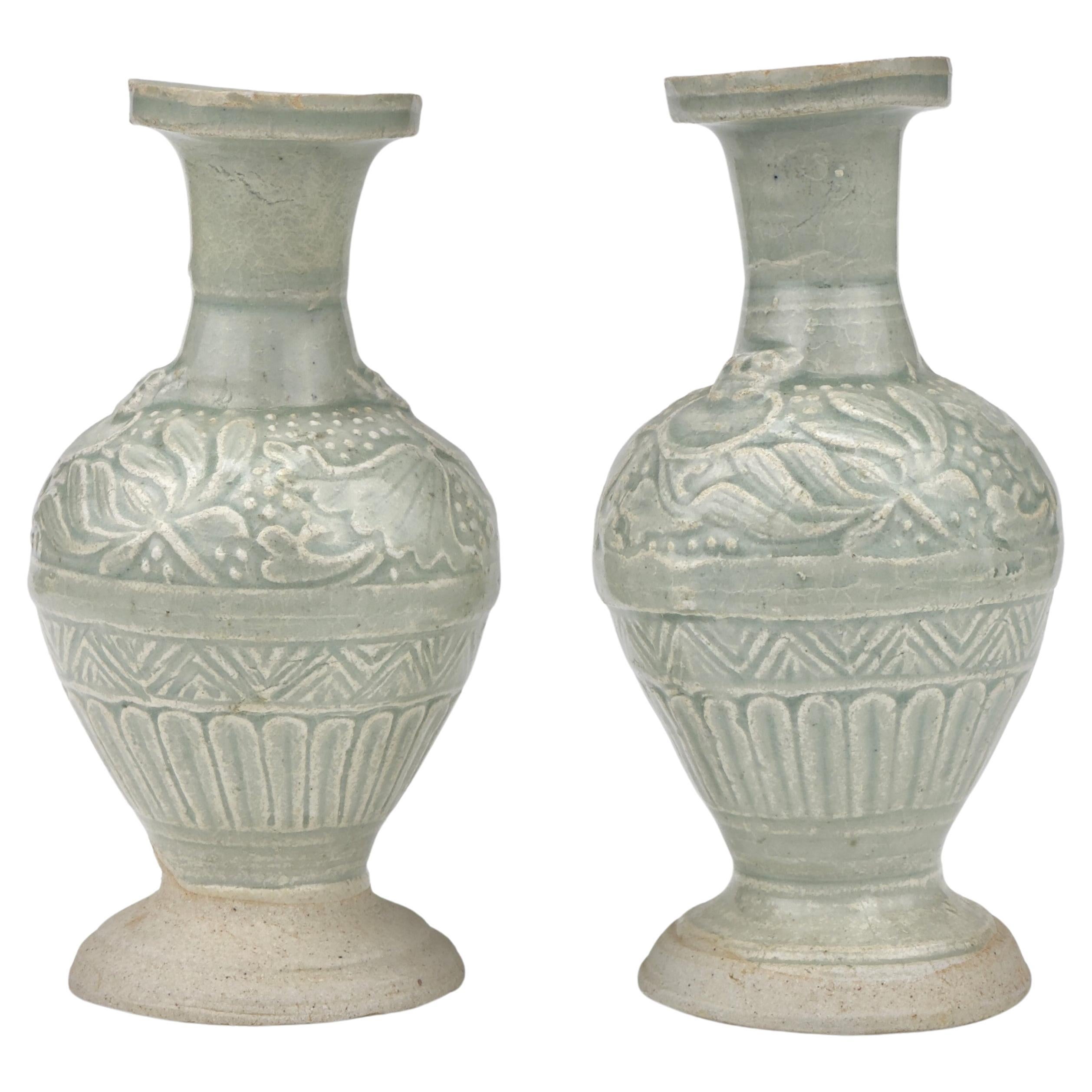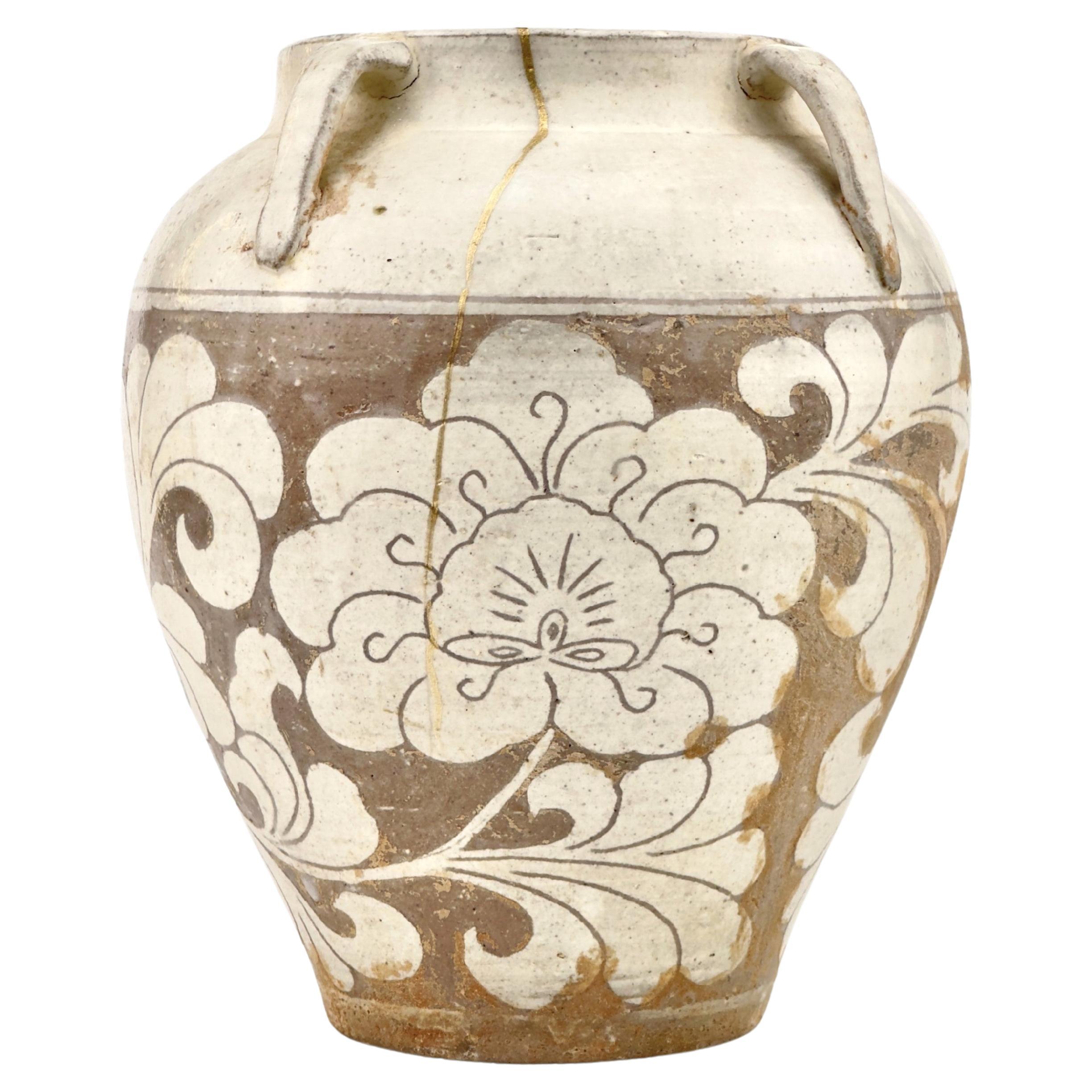Items Similar to A Carved Qingbai 'Chrysanthemum' Vase, Song-Yuan Dynasty(13-14th century)
Want more images or videos?
Request additional images or videos from the seller
A Carved Qingbai 'Chrysanthemum' Vase, Song-Yuan Dynasty(13-14th century)
About the Item
The ovoid body to a tall neck, the body decorated with a chrysanthemum meander, covered overall in a translucent pale blue glaze. Traces of excavation can be seen in the dirt marks on the lower part. Even when observed under a microscope, traces of soil naturally settling inside the bubbles can be found. Elaborate craftsmanship is displayed at the entrance.
Period : Song-Yuan Dynasty(13-14th century)
Type : Vase
Medium : Qingbai Ware
Size : 24 cm(Height), 10cm(Mouth Diameter)
Provenance : Acquired in late 1990s from Hongkong
Condition : Excellent
Reference :
1) Christies Newyork 23 MAR 2023 - J. J. Lally & Co. - Lot 880
(Price realised : USD 40,320 / Type : Closely related)
2) Sotheby's Hong Kong 22 April 2021 - Monochrome III - Lot 31
(Price range : 300,000 - 500,000 HKD / Type : Closely related)
3) Sotheby's New York 15 March 2017 - Important Chinese Art - Lot 636
(Price realised : 25,000 USD / Type : Closely related)
* Qingbai Ware
Qingbai ware, which translates to "blue-white ware," is a type of Chinese porcelain that was made at the Jingdezhen and other kilns in the porcelain-producing regions of China, primarily during the Song dynasty (960–1279) and continuing into the Yuan dynasty (1271–1368). It is known for its translucent quality and the pale blue-green glaze that characterizes most of its pieces.
The qingbai glaze was achieved using a small amount of iron in a reduction-fired atmosphere, which produced the subtle blue-green tint. The body of qingbai ware is typically made of a fine, white porcelain that is often referred to as 'artificial jade' due to its resemblance to the esteemed stone. The thinness of the body and the high firing temperatures used contributed to the translucent quality of the finished product.
Qingbai ware includes a range of items such as bowls, cups, vases, and ewers. The designs are usually simple and elegant, with an emphasis on the graceful lines and form of the objects. Decorative motifs, when present, are often incised, carved, or molded in relief and can include floral patterns, dragons, phoenixes, and other symbolic elements drawn from Chinese culture.
Over time, the technology and techniques used to produce qingbai ware evolved, leading to innovations in glaze and decoration that would influence later types of Chinese porcelain. Despite these changes, qingbai ware remains a distinguished example of the potters' art in Song and Yuan China, reflecting the refined aesthetic and cultural values of the period.
- Dimensions:Height: 9.45 in (24 cm)Diameter: 3.94 in (10 cm)
- Style:Ming (Of the Period)
- Materials and Techniques:
- Place of Origin:
- Period:
- Date of Manufacture:13-14th century
- Condition:Minor fading.
- Seller Location:seoul, KR
- Reference Number:1stDibs: LU9577239483392
About the Seller
New to 1stDibs
Joined in the past six months.
4.5
Vetted Seller
These experienced sellers undergo a comprehensive evaluation by our team of in-house experts.
Established in 1999
1stDibs seller since 2023
Typical response time: <1 hour
- ShippingRetrieving quote...Ships From: seoul, Korea South
- Return PolicyA return for this item may be initiated within 10 days of delivery.
More From This SellerView All
- Small Qingbai Pear-Shaped Vase, Song-Yuan Dynasty(13-14th century)Located in seoul, KRThis exquisite piece is a Qingbai ware from the Song to Yuan dynasty, and it appears to be an excavated artifact given its earthy encrustations, suggesting it has rested in the groun...Category
Antique 15th Century and Earlier Chinese Ming Antiquities
MaterialsCeramic, Porcelain
- Two white ware vases with flower design, Yuan Dynasty, 14th centuryLocated in seoul, KRPorcelain with transparent pale-green (qingbai-type) glaze with flower, leaves and lotus design of typical yuan dynasty. Period : Yuan Dynasty(1271-1368) Type : Baluster vase Medium...Category
Antique 15th Century and Earlier Chinese Ming Antiquities
MaterialsPorcelain, Ceramic
- White Ware with two dragons, Yuan Dynasty, 13-14th centuryLocated in seoul, KRThis vase is made from a type of low-fired, porous clay and features a crackled glaze. It bears resemblance to the renowned funerary vases and covers adorned with applied decorations...Category
Antique 15th Century and Earlier Chinese Chinese Export Antiquities
MaterialsCeramic, Porcelain
- Cizhou Lotus Carved Jar, Song-Yuan dynastyLocated in seoul, KRThis jar features a carved design, which is typical of Cizhou ware. It has a creamy white and brown color scheme, and the prominent decoration of lotus flower, which is a common motif in Chinese art and culture, symbolizing purity and enlightenment. The carving technique involves coating the vessel with a layer of white slip (liquid clay), then carving away parts of it to create the design, revealing the darker clay body beneath. This technique allows for a strong contrast between the background and the carved motif. Period : Song-Yuan Dynasty Type : Jar Medium : Cizhou Ware Size : 21.5 cm(Height), 11cm(Mouth Diameter) Provenance : Acquired in 1999, Hongkong * Cizhou Ware Cizhou is the name given to a number of stonewares, grey or buff, of varying degrees of hardness, with painted, incised or carved decoration on a clay slip. These stonewares were not only made in the region of Cizhou, Hebei Province, but in several provinces of China during the Song, Yuan and Ming periods. The great centres of production were in the north of China in the provinces of Hebei, Henan and Shanxi. Cizhou wares seem to have been very popular, made for a clientèle of rich merchants, at a period when the paintings of famous...Category
Antique 15th Century and Earlier Chinese Ming Antiquities
MaterialsPottery
- A Carved White Ware 'peony' vase, Song-Yuan dynastyLocated in seoul, KRThe vase is raised on a slightly splayed foot and flanked on the tall cylindrical neck by a pair of mask handles. The body is molded with lotus scroll pattern between a floral scroll...Category
Antique 15th Century and Earlier Chinese Chinese Export Antiquities
MaterialsCeramic, Porcelain
- White Ware Moulded Baluster Form, Yuan Dynasty, 14th centuryLocated in seoul, KRThis vase is made from a type of low-fired, porous clay and features a crackled glaze. It bears resemblance to the renowned funerary vases and covers adorned with applied decorations...Category
Antique 15th Century and Earlier Chinese Chinese Export Antiquities
MaterialsCeramic, Porcelain
You May Also Like
- Antique Ceremonial Urns, Song Dynasty, 12th-13th CenturyLocated in New York, NYTwo tall ceremonial urns dating from the 12th-13th century, Southern Song dynasty. These two stunning vases depict 12 traditional ritual attendan...Category
Antique 15th Century and Earlier Chinese Other Antiquities
MaterialsCeladon
- 13th/early 14th C' Sukothai Walking Buddha, 8993Located in Ukiah, CAAll time favorite, and the first Buddha I have not wanted to post for sale in many years, as my heart melted the first time I laid eyes on him and I wanted to claim him for my own. He is the best of Thai sculpture- EARLY (13th/early 14th C) Sukothai Walking Buddha...Category
Antique 15th Century and Earlier Thai Antiquities
MaterialsBronze
- Lopburi Style Cast Bronze Figure of Uma, 13th-14th Century, ThailandLocated in Austin, TXA charming and unusual cast bronze figure of the Hindu goddess Uma, Lopburi Style, 13th-14th century, Thailand. Uma, the Hindu goddess of love and beauty, also known as Parvati, i...Category
Antique 15th Century and Earlier Thai Sculptures and Carvings
MaterialsBronze
- 17th Century Ming Dynasty Carved Stone Barrel #01Located in Chicago, IL17th Century Ming Dynasty carved marble garden seat with Foo Dog handles, floral reliefs and bat wing decoration. The Chinese symbol for bat and fo...Category
Antique 17th Century Chinese Ming Antiquities
MaterialsMarble
- Rare Chinese Buddhist Altar Table, Yuan Dynasty, 14th CenturyLocated in Prahran, VictoriaRare Chinese Buddhist altar table made from bai-mu cypress wood with an elaborate, deeply carved and pierced relief. It also features a floral apr...Category
Antique 15th Century and Earlier Chinese Other Furniture
MaterialsCypress
- Antique Shigaraki Jar "Uzukumaru"/Japanese Vase/14th-16th Century/Wabi-SabiLocated in Kyoto-shi, KyotoDuring the Muromachi Period (1392–1573), the concept of wabi-sabi was formed from the tea ceremony culture. Shigaraki ware was greatly influenced by the aesthetic sense of tea masters in the flow of the times. This product is a small jar called "UZUKUMARU", which was used by farmers as a pot to store seeds. The higaki pattern drawn on the body is unique to Shigaraki. It is said that it is modeled after a shimenawa rope or the bamboo fence...Category
Antique 15th Century and Earlier Japanese Antiquities
MaterialsCeramic
Recently Viewed
View AllMore Ways To Browse
Marble Top Table With Iron Base
Informal Table
Brazilian Armchair Contemporary
Bar Stools By Unknown
Oval Table Metal Top
Huge Mid Century Chandeliers
Lounge Chair With Iron
Argentinian Lamp
Fine Compacts
Steel Cylinder Lamp
Large Woven Moroccan Rug
Midcentury Square Side End Tables
Bernini Italian
Italian Brass Mirror Murano
Ralph Lauren Living Room
Antique Gilded Mirror Frames And Mirrors
Danish Teak Vodder
French Small Commode Chest





